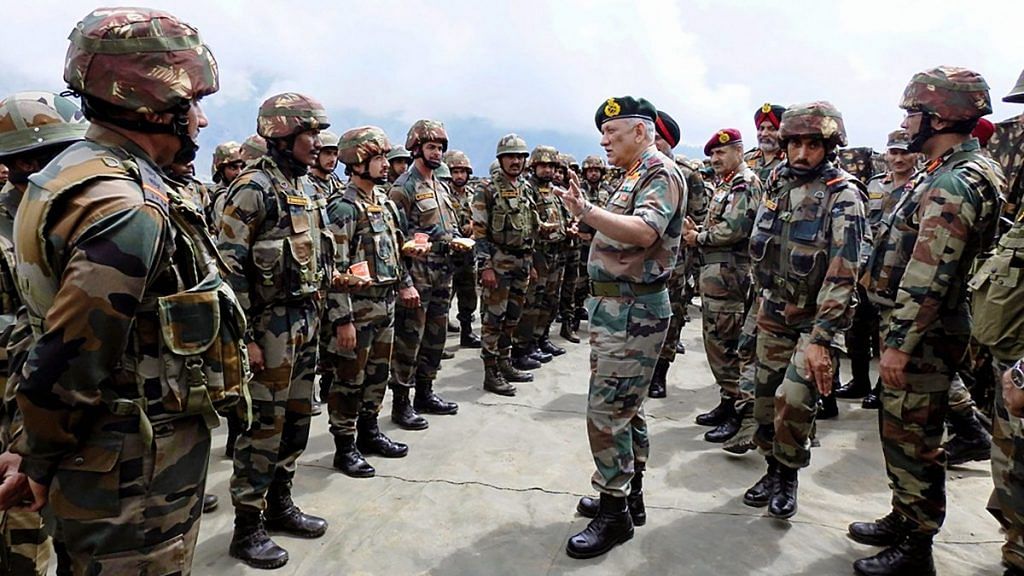New Delhi: Over 15,000 soldiers backed by tanks, medium artillery, helicopters and transport aircraft will be part of the Mountain Strike Corps’ maiden exercise, ‘HimVijay’, at over 10,000 feet in Arunachal Pradesh next month.
The exercise will be held away from the Line of Actual Control (LAC) with China. It will coincide with the expected visit of Chinese President Xi Jinping next month.
The exercise assumes greater significance because the Army will for the first time see in action its integrated battle groups (IBGs) — the brainchild of Army Chief Gen Bipin Rawat.
Sources said three mountain IBGs carved out of the Panagarh-based 17 Corps’ (Mountain Strike Corps) 59 Mountain Division will be in action.
The exercise will be keenly watched by the top security czars of the Narendra Modi government and the Army chief as the IBGs are touted to be the mainstay of future operational strategies in the Western, Northern and Eastern theatres.
Also read: The 3 major reforms for Indian Army restructuring and what they will mean for the force
Exercise to involve IAF, 15,000 soldiers
Operation ‘HimVijay’ will see the participation of 15,000 personnel, with each IBG consisting of nearly 5,000 troops backed by a combination of tanks, artillery and other assets. The IAF will be roped in for strategic airlift of personnel and equipment.
The exercise will see in action the AN32s, C130J Super Hercules and the C17s besides helicopters from both the Army Aviation and the IAF.
Sources said assets with the Tezpur-based 4 Corps will be used in the operation while personnel would be completely from the Mountain Strike Corps. Army sources remained tight-lipped about the scope of the massive exercise but indicated that multiple objectives have been laid out and that planning has been on for the last several months.
“The exercise will be held in Arunachal Pradesh and will see in action three IBGs involving 5,000 troops each,” an Army source told ThePrint. Asked if China has been informed, the source said, “The exercise is being held a little further from the LAC.”
The only assets that would not be a part of the exercise are the BrahMos missiles, sources said.
Also read: Satellite images show China road runs deep into Arunachal: Defence expert Abhijit Iyer-Mitra
Integrated Battle Groups
In a bid to ensure faster punitive and defensive operations, Gen Rawat had envisioned the IBGs, which are brigade-sized self-sufficient agile formations.
The IBGs are part of the reforms in the way the Indian Army functions and are to replace the current concept of the Cold Start Doctrine.
The doctrine called for defensive corps to carry out shallow cross-border thrusts within 72 hours for limited objectives such as the capture of territory.
The Army, however, found itself wanting in 2001 after the then government ordered it to march ahead in the wake of the Parliament attack that December. It took nearly three weeks for the Army to deploy its strike corps to the border, which cost it the valuable surprise element.
The Army then worked on the Cold Star doctrine, something that was not acknowledged for very long or exercised in its full spectrum until Gen Rawat took over in 2016.
The new Army leadership felt that the 72 hours notice was also very long.
Gen Rawat wanted to create integrated units for the border that will be self-sufficient with artillery, armoured, combat engineers and signal units.
As such, each corps is to have three divisions, with each division to have three brigades. The overall idea is to break down the divisions into IBGs with all essential elements.
The IBGs are primed to strike in less than 24 hours. They will be sector and terrain specific — in effect, the IBGs in the North will not be the same as the IBGs in the Western sector.
The resources, in terms of equipment, will be determined by the terrain, enemy threat and the task.
Also read: Dear General Bipin Rawat, this is what is wrong with your military reforms
